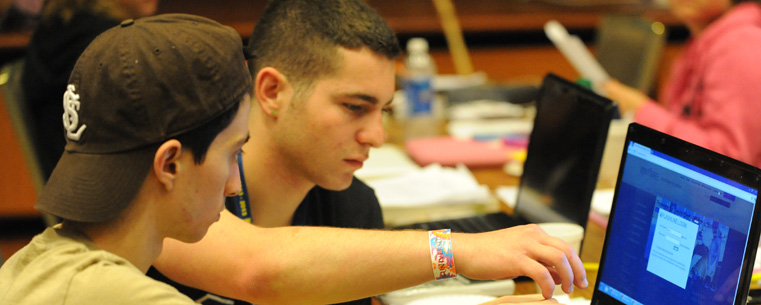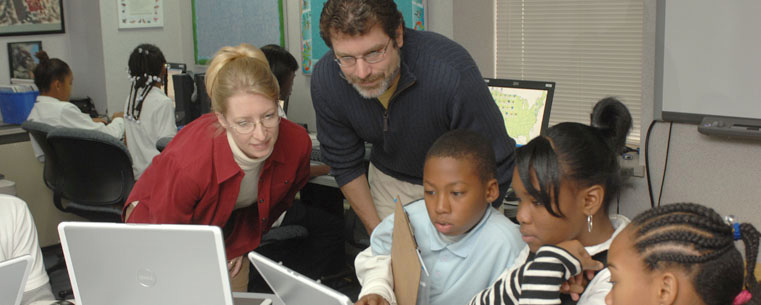Recent Success Stories
- New Kent State President Embarks on Listening Tour
- Scholar Helps Fight Crime With Violence Prevention Research
- Welcome, President Warren
- Destination
Kent
State
Returns - Now Serving More Than 300 Student Organizations
- Visit Kent State
- Kent State Captures Eighth Jacoby Trophy
- Scholar Supplies Global Technology Knowledge to Students





All Study Strategies Not Created Equal, According to Kent State Researchers
Students everywhere, put down those highlighters and pick up some flash cards! Some of the most popular study strategies – such as highlighting and even rereading – do not show much promise for improving student learning, according to a new report authored in part by two Kent State University researchers.
Kent State’s John Dunlosky, professor of psychology, and Katherine Rawson, associate professor of psychology, and a team of distinguished psychological scientists reviewed the scientific evidence for 10 learning techniques commonly used by students. Their findings are published in Psychological Science in the Public Interest, a journal of the Association for Psychological Science.
“Schools and parents spend a great deal of money on technology and programs to improve student achievement, even though evidence often isn’t available to firmly establish that they work,” Dunlosky said. “We wanted to take a comprehensive look at promising strategies now, in order to direct teachers, students and parents to the strategies that are effective yet underused.”
Based on the available evidence, the researchers provide recommendations about the applicability and usefulness of each technique. While the 10 learning techniques vary widely in effectiveness, two strategies – practice testing and distributed practice – made the grade, receiving the highest overall utility rating.
Effective Study Strategies
Most students are probably familiar with practice testing, having used flash cards or answered the questions at the end of a textbook chapter. Students who prefer last-minute cram sessions, however, may not be as familiar with the idea of distributed practice.
Dunlosky and colleagues report that spreading out your studying over time and quizzing yourself on material before the big test are highly effective learning strategies. Both techniques have been shown to boost students’ performance across many different kinds of tests, and their effectiveness has been repeatedly demonstrated for students of all ages.
Ineffective Learning Techniques
In contrast, five of the techniques received a low utility rating from the researchers. Notably, these techniques are some of the most common learning strategies used by students, including summarization, highlighting and underlining and rereading.
“I was shocked that some strategies that students use a lot – such as rereading and highlighting – seem to provide minimal benefits to their learning and performance,” Dunlosky said. “By just replacing rereading with delayed retrieval practice, students would benefit.”
Successful Strategies Underused
So why don’t they? Why aren’t students and teachers using the learning strategies that have been shown to be effective and inexpensive?
Dunlosky and colleagues found that the answer may have to do with how future teachers are taught.
“These strategies are largely overlooked in the educational psychology textbooks that beginning teachers read, so they don’t get a good introduction to them or how to use them while teaching,” Dunlosky explained.
As a result, teachers are less likely to fully exploit some of these easy-to-use and effective techniques.
Solution to Address Gap
To help address this gap, the researchers organized their report in distinct modules, so that teachers can quickly decide whether each technique will potentially benefit his or her students and researchers can easily set an agenda on what we still need to know about the efficacy of these strategies.
“The learning techniques described in this monograph will not be a panacea for improving achievement for all students, and perhaps obviously, they will benefit only students who are motivated and capable of using them,” Dunlosky and colleagues noted. “Nevertheless, when used properly, we suspect that they will produce meaningful gains in performance in the classroom, on achievement tests and on many tasks encountered across the life span.”
The report, “Improving Students’ Learning With Effective Learning Techniques: Promising Directions From Cognitive and Educational Psychology,” is published in the January 2013 issue of Psychological Science in the Public Interest and is authored by Dunlosky and Rawson with Elizabeth Marsh of Duke University, Mitchell Nathan of the University of Wisconsin-Madison and Daniel Willingham of the University of Virginia.
The research included in the report was supported by a Bridging Brain, Mind and Behavior Collaborative Award through the James S. McDonnell Foundation’s 21st Century Science Initiative.
The full report is available for free online.
See the full-size versions of the images in the above carousel.

Facebook
Twitter
Google+
LinkedIn
Instagram
YouTube
More Ways to Connect